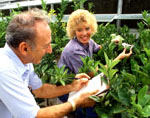|
University of Georgia – Tifton Campus (John M. Ruter)
Research and extension programs for nursery production have focused in recent years on reducing phosphorus loading in container nurseries and solving growth abnormalities associated the container-production of river birch (Betula nigra) and Chinese fringe flower (Loropetalum chinese var. rubrum).
Container nurseries utilizing 100% liquid feed systems often inject between 15 to 40 ppm of phosphorus (P) with every irrigation. As only a small percentage of the fertilizer solution ends up in the potting substrate, losses of P in such situations can be substantial. Our research has shown that broadleaf evergreens and conifers can be successfully grown with 10 ppm P, thereby reducing losses of P in runoff.
Research initiated in 2001 indicated that incorporation of calcined clay at ~10% by volume was superior to iron oxide, synthetic polymers, and zeolites in reducing the amount of P leaching from containers. When incorporated at 10% by volume, particle size of the calcined clay had little influence on binding of P. Further research indicated that there was little difference in binding of P when calcined clay was incorporated at between 5% and 10% by volume. When calcined clays are used, reductions in P leaching of up to 70% can be found. Non-calcined clays are not effective in reducing leaching of P from pine bark substrates. While calcined clay is effective, costs of the material can be prohibitive at this time.
River birch suffers from a growth abnormality known as mouse ear. In 2003 our research showed that mouse ear of container-grown river birch was caused by a deficiency of nickel. Two preventative spray applications per year can prevent mouse ear from occurring. A commercial source of nickel lignonsulfonate (Advance NiTM) is available.
In 2005 our research showed that little-leaf disorder of container-grown Loropetalum was caused by a deficiency of copper. Too date, the success of foliar applications of copper products has been variable. Incorporation of additional copper into the substrate at potting has been successful in 2006. Work on this problem is continuing.
|





